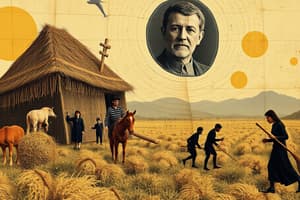Podcast
Questions and Answers
What was systematic agriculture?
What was systematic agriculture?
Systematic agriculture is growing food on a regular basis.
How did specialization affect the lives of Neolithic peoples?
How did specialization affect the lives of Neolithic peoples?
Specialization allowed fewer people to farm and more to engage in other economic activities and crafts.
What was the Agricultural Revolution?
What was the Agricultural Revolution?
The Agricultural Revolution is settled farming during the Neolithic Age.
How did farming lead to new types of economic activities?
How did farming lead to new types of economic activities?
What are the advantages and disadvantages when a community grows?
What are the advantages and disadvantages when a community grows?
Which groups made up the largest social class in early civilizations?
Which groups made up the largest social class in early civilizations?
You are the leader of a band of hunter-gatherers. What would you say to persuade your band to settle and begin farming?
You are the leader of a band of hunter-gatherers. What would you say to persuade your band to settle and begin farming?
Flashcards are hidden until you start studying
Study Notes
Systematic Agriculture
- Involves regularly growing food, marking a significant shift from foraging to farming.
Specialization in Neolithic Societies
- Surplus food production reduced the need for all individuals to farm, leading to diversification of roles.
- Emergence of artisans skilled in crafts such as weapon-making, jewelry, pottery, and weaving.
- Barter system developed, allowing exchange of goods between communities.
Agricultural Revolution
- Refers to the transition to settled farming practices during the Neolithic Age.
Economic Activities from Farming
- Consistent food supplies led to healthier and growing populations.
- Increased population allowed for greater agricultural output and diversification of economic roles beyond farming.
- Villagers began trading excess produce for necessary supplies.
Advantages and Disadvantages of Community Growth
- Growth offers greater manpower for farming and production of goods.
- Rapid population increases can exhaust natural resources, leading to environmental issues like deforestation and desertification, resulting in abandoned settlements.
Social Structure in Early Civilizations
- The upper social class included rulers, priests, government officials, and warriors who governed society.
- A significant middle class comprised free individuals such as farmers and artisans.
- Enslaved individuals, often captured in warfare, occupied the lowest tier of the social hierarchy.
Persuasion to Settle and Farm
- Emphasized the advantages of living near rivers for fishing and access to water.
- Highlighted the importance of stable homes for protection against the elements and wildlife.
- Promoted the idea of food security through farming to alleviate hunger.
Studying That Suits You
Use AI to generate personalized quizzes and flashcards to suit your learning preferences.





